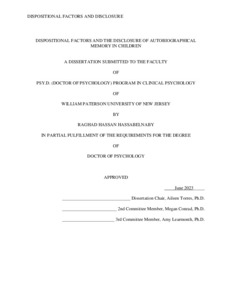Please use this identifier to cite or link to this item:
http://hdl.handle.net/20.500.12164/3331Full metadata record
| DC Field | Value | Language |
|---|---|---|
| dc.contributor.author | Hassabelnaby, Raghad | - |
| dc.date.accessioned | 2023-12-15T17:55:49Z | - |
| dc.date.available | 2023-12-15T17:55:49Z | - |
| dc.date.issued | 2023-06 | - |
| dc.identifier.uri | http://hdl.handle.net/20.500.12164/3331 | - |
| dc.description.abstract | Disclosure of past personal experiences (i.e., autobiographical memories; AMs) is critical to clinical work as it provides essential material for assessment and psychotherapy. Previous research has explored some of the factors that contribute to increased disclosure. However, research directly examining the connection between dispositional factors (i.e., personality, temperament) and AM disclosures is sparse. The current study explored the relationship between dispositional factors and the disclosure of valenced (i.e., positive, negative) AMs among 8–10-year-old children. Fifty-four parent/child dyads participated in the study in which parents completed measures of their child’s personality/temperament (i.e., Extraversion, Openness, Agreeableness, Anxiety, Shyness, Sadness, Inhibitory control). Children also completed a measure of their self-perceived personality. During the study, children recalled/disclosed a self-selected positive and negative AM following a standard protocol. The AM disclosures were transcribed and then coded using LIWC (Boyd et al., 2022) into the following facets: Volume, Authenticity, Clout, Analytical thinking, and Insight. In this study, low parent-child concordance was observed on all personality variables. Also, valence of AMs was not relevant, except when it came to the Clout facet as participants were consistent in disclosing past experience for both positive and negative events. No significant correlations emerged between sadness or inhibitory control, and AM facets. However, significant relationships were found between other temperament and personality factors and AM facets. These relationships are discussed in terms of their role in serving as potential facilitators or obstacles to higher quality/quantity disclosures. Potential clinical implications, limitations of the study, and future direction are also addressed. | en_US |
| dc.format.extent | 43 pages | en_US |
| dc.language.iso | en_US | en_US |
| dc.publisher | William Paterson University | en_US |
| dc.subject | Psychology | en_US |
| dc.subject | Autobiographical memories | en_US |
| dc.subject | Children | en_US |
| dc.subject | Disclosure | en_US |
| dc.subject | Dispositional factors | en_US |
| dc.subject | Personality | en_US |
| dc.subject.lcsh | Psychology | en_US |
| dc.title | Dispositional Factors and the Disclosure of Autobiographical Memories Among Children | en_US |
| dc.type | Dissertation | en_US |
| Appears in Collections: | Theses & Dissertations | |
Files in This Item:
| File | Description | Size | Format | |
|---|---|---|---|---|
| Hassabelnaby_DispositionalFactorsDisclosure.pdf | 319.09 kB | Adobe PDF |  View/Open |
Items in DSpace are protected by copyright, with all rights reserved, unless otherwise indicated.
